Postnatal exercise
Postnatal care
The first few weeks with a newborn infant can be very demanding, so it is important to remind the mother to make time for her. Time out everyday is vital. Relaxation technique are important and can be helpful for sleep and alleviate the build up of stress. You could advise one of the following positions.
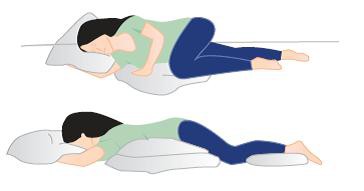
Looking after the back
Pregnancy results in gradual changes in the body, which do not return immediately to normal, but guidance in this leaflet and regular exercise will help mothers regain strength.
It is common to develop lower back pain, shoulder and upper spine tenderness and stiffness during and after pregnancy. This may be due to changing body shape, weakness of muscles, and increased demands placed on the body with the new arrival.
It can take up to five months for the ligaments to fully tighten up after the infant’s delivery, so adherence to good posture in all activities of daily living is vital. To help encourage correct muscle activation and reduced joint strain, try advising the practice of some of the following techniques:
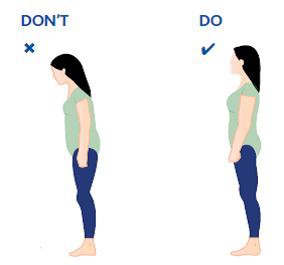
When feeding the infant, it is advised to sit tall, preferably on an armchair, with arms and shoulders relaxed. A small footstool under the mothers feet, and a small roll at the small of their back, will ensure their back is well-supported.
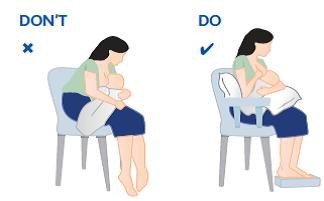
When getting out of bed, they should bend both knees, press them together and roll over onto their side before sitting up. Reverse to lie down.
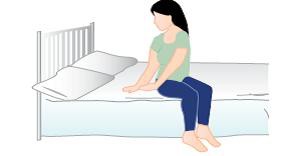
Avoid any unnecessary lifting and take smaller loads.
Avoid bending forward postures when caring for the infant as repeatedly doing this will cause wear and tear on the back. When lifting, always use your leg muscles to do the work.
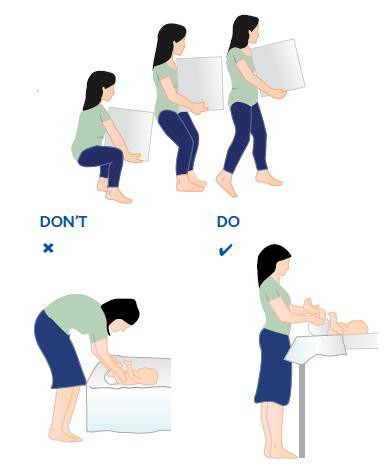
Exercises for the muscles stretched and weakened by pregnancy and birth
Pelvic floor muscles
Following childbirth, leakages can sometimes occur from the front and/or back passage. This may resolve after a short time. Exercises can help but if the problem persists beyond twelve weeks post-natally, women are advised to contact your Chartered Physiotherapist in Women’s Health, Public Health Nurse or GP.
What are they?
The pelvic floor forms a broad sling of muscle, lying across the bottom of the pelvis, through which pass the openings from the bowel, vagina (birth passage) and the urethra (passage from the bladder).
They are the main support for the pelvic organs and give control of the three passages.
It is important to make them strong again as weakness of the pelvic floor can cause symptoms such as leakage of urine when coughing, urgent or frequent need to pass urine, leakage of wind and/or stool from the back passage, or decreased satisfaction during intercourse.
Postnatal women may have stitches in or near their vagina. The muscles may feel weak and sore, but this exercise will ease the pain and start to strengthen them. Try to start gently within a few hours of the birth.
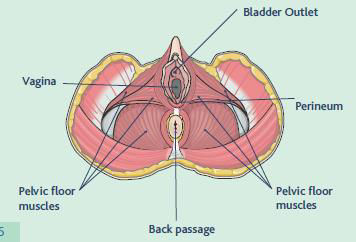
Pelvic floor exercise
Tell mothers to imagine that they are trying to stop themselves from passing wind and at the same time trying to stop their flow of urine mid-stream. The feeling is one of ‘squeeze and lift’, closing and drawing up the back and front passages.
- Hold the muscles up whilst breathing.
- Then relax fully and let their pelvic floor lower again.
- Repeat 10 times.
- Always rest for a few seconds before repeating the exercise.
Gentle rhythmical squeezes, in the first 48 hours after childbirth will help ease pain and reduce swelling. These should be done frequently, for 30 seconds at a time.
- Once the pain and discomfort has eased, aim to hold the lift for 3-4 seconds, gradually aiming to increase the hold time to 10 seconds as your muscles become stronger.
- Repeat as many times (up to a maximum of 10 repetitions at a time).
This routine should be practised as often as possible. Mothers should feel their lower tummy (below your tummy button) tightening gently as they do this. However, it is very important to do this exercise without pulling in the whole tummy, squeezing the legs together, tightening the buttocks or holding their breath.
Add some quick strong squeezes to the 10-second hold, remembering to relax completely after each exercise.
Quickly lift and squeeze the pelvic floor muscles prior to laughing, coughing, sneezing or lifting; this will protect the pelvic floor and prevent undue pressure on the muscles. This technique is known as “the knack”. Mothers should get into the habit of using “the knack” in all situations where extra pressure is coming on the pelvic floor, including each time they stand up, or lift their infant.
How to know if you are doing your exercises correctly:
- Try to gently slow or stop the flow of urine towards the end of the stream, then relax and finish emptying their bladder. This is a test, and not an exercise. It should not be done more than once a week.
- If in doubt, they should be referred to their GP or Chartered Physiotherapist in Women’s Health.
Return to exercise
If you have had a Caesarean section or had limited mobility during pregnancy, please contact your GP or Midwife before resuming activities. All return to exercise should be on a gradual pain-free basis. Walking is a terrific exercise, so when you feel able, start with a slow pain-free 10 minute walk. As you regain strength, you can increase the length, frequency and speed of the walks. Taking your pelvic floor to the third floor and holding for 20 seconds as you walk is a great way to exercise your pelvic floor. However, remember to fully relax it between exercises as failure to release the muscle fully between contractions can lead to dysfunction of the muscle.
Abdominal muscles
You may start the following exercises within days of the birth as long as they are pain-free and do not cause strain. Aim to do the exercises twice a day.
1. Deep tummy exercise
Lie on your back with your knees bent:
- Breathe in; as you breathe out, gently draw your lower abdomen in towards your spine.
- Hold for a few seconds, breathing normally, then relax. Be careful not to move your back or pelvis.
- Start holding for 5 seconds and progress to holding for 10 seconds as you get stronger.
- Repeat 10 times.
- Try drawing in your pelvic floor at the same time if possible.
This exercise can also be done while sitting and standing, once you have mastered it in lying.
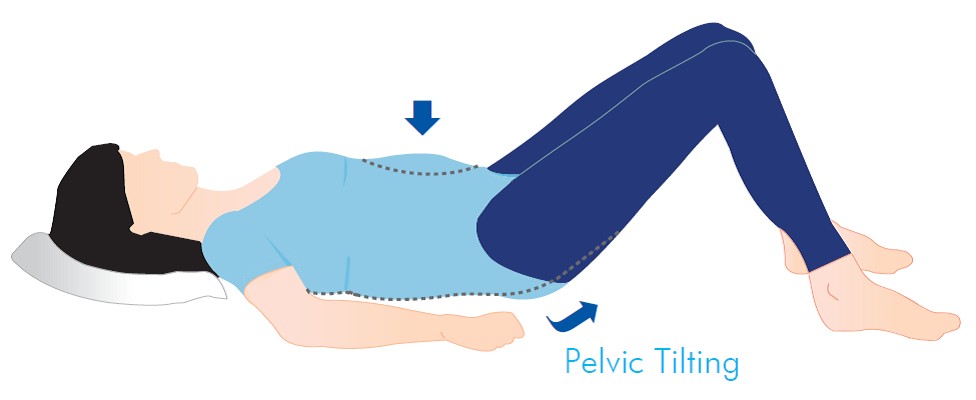
2. Pelvic tilt
With your head on a pillow, lie on your back with knees bent and feet flat on the bed:
- Draw in your belly button and gently flatten your lower back into the bed.
- As you flatten your back your buttocks will gently raise up off the bed.
- Hold this position for 5-10 seconds (it is important not to hold your breath), then gently let go.
- Repeat 10 times.
Once you have mastered this exercise, it can be practised in any position, side-lying, sitting or standing.
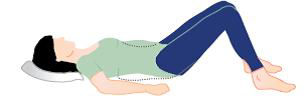
3. Shoulder and upper spine stretch
- Repeat exercise 2.
- While your back is flat against the bed, clasp hands and bring arms up over head.
- Do not allow back to lose contact with the bed and do not push into pain.
- Return to starting position.
- Repeat 10 times.
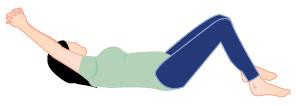
4. Clam exercise for glutes
Lying on side with knees bent:
- Draw in belly button and raise top leg upwards keeping feet together.
- Keep pelvis steady and feet together as you raise your leg upwards.
- Return to starting position.
- Hold from 1-10 seconds and repeat 10 times

Initially after having a baby your tummy muscles remain stretched and lengthened down the centre of your abdomen leaving a gap in the middle which may take some weeks to close. Before progressing with the exercises, you need to ensure that there isn’t a gap or hollow in your tummy muscles. This can be done as follows:
- Lie on the floor with your knees bent and gently place the finger tips of one hand down and into your abdomen just 2 finger widths above your tummy button.
- Take your pelvic floor muscles to the third floor as described earlier, then lift your head and shoulders towards your toes, breathing normally as you do this.
- You may feel a slight gap which closes across your fingers as your head lifts. If this gap has not closed at 6 weeks post-natally, you should get your GP to refer you to a Chartered Physiotherapist who can show you how to deal with this problem effectively.
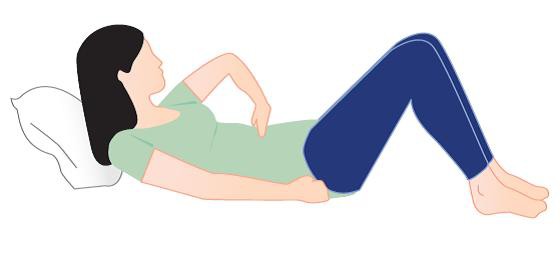
Increase the number of repetitions as you feel able
- Remember to listen to your body
- Stop if it hurts
- Stop when tired
- Remember to practice good posture and back care
- At times of stress remember to practice relaxation
If you need advice about increasing activity or to determine if you are ready to resume sporting activities, please ask your GP, or contact your Chartered Physiotherapist in Women’s Health.
Above all, enjoy being a mum!
Some important things to know about your baby
The World Health Organisation Guidelines recommend that babies should be placed on their backs for sleep to reduce the risk of cot death. It is very important to follow this advice. However, it is important that babies spend some time on their tummies every day.
Why should babies have tummy time?
- They achieve better head control and stronger muscles in their neck, shoulders, arms and backs.
- Babies move from side to side on their tummies which helps them learn how to reach and crawl.
- They develop better balance and co-ordination.
- Vision and hand-eye co-ordination are enhanced.
Babies should be placed on their tummies from day 1, for just a few minutes three times daily initially, gradually building up the length of time. Initially, you can place your baby on your chest, facing you. This is a great way to play with your baby, and to make eye contact with him, which is one of the first steps in communication with your baby. Your baby may not like being on his tummy initially, so start slowly, but persevere! The benefits to your baby are worth the effort.
Your baby should NEVER BE LEFT ALONE while on his tummy.
Too much time on their backs can cause a delay in babies acquiring movement skills, and can also cause flattening of the side of their head. To avoid this, alternate which end of the cot you place the baby’s head at night; babies will naturally turn towards the light or coloured objects in the room which will change the area of pressure on the baby’s head.
The best piece of equipment you can invest in for your baby is a colourful mat to place on the floor, so that he can enjoy his tummy time on it while exploring his environment in your company!

It is very important to engage with your baby by using eye contact. With your baby lying on a flat surface, or on your tummy as in the image above, encourage your baby to make eye contact with you in midline (ie. when your baby’s nose is in line with your baby’s belly button).
Encourage your baby to follow your face from side to side and up and down, coming back to midline after each movement. This is the start of communication and head control.
Floor time: The floor is the best place for your baby to spend his awake time. This may be difficult if you have young toddlers, but a playpen can overcome this difficulty. Your baby needs time on the floor, completely unsupported and with as little clothes on as possible to become familiar with their bodies and their ever developing movements. Between the ages of 0 and 2, if your baby is not asleep, he should be moving. This is how he develops and begins to learn.
Enjoy getting to know your new little member of your family!
Help us provide information most relevant to you
Please ensure your role and areas of interest are up to date.
